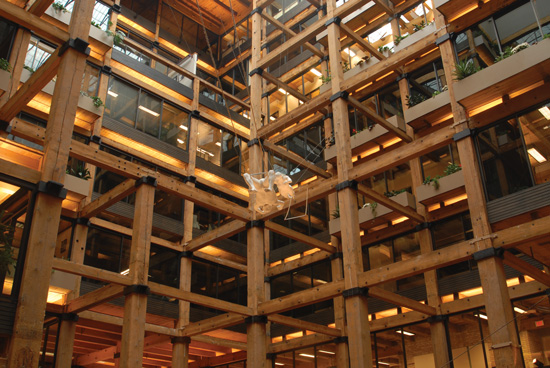Designing for Durability
Strategies for achieving maximum durability with wood-framed construction
![]() Continuing Education
Continuing Education
Use the following learning objectives to focus your study while reading this month’s Continuing Education article.
Learning Objectives - After reading this article, you will be able to:
- Analyze factors contributing to the long-term durability of wood buildings.
- Implement effective design strategies for controlling moisture in wood buildings.
- Discuss comprehensive approaches for protecting wood buildings from insect damage.
- Determine effective quality control measures that will have significant positive long-term impact on building durability.
Architects specify wood for many reasons, including cost, ease and efficiency of construction, design versatility, and sustainability—as well as its beauty and the innate appeal of nature and natural materials. Innovative new technologies and building systems are also leading to the increased use of wood as a structural material, not only in houses, schools, and other traditional applications, but in larger, taller, and more visionary wood buildings. But even as the use of wood is expanding, one significant characteristic of wood buildings is often underestimated: their durability.
If buildings are designed with local climate impacts in mind, wood buildings stand the test of time. When used in tandem with proper envelope design, building with wood can reduce future maintenance and repair costs. Good design also ensures that wood materials last and weather well in various climates, including those with high humidity, frequent sun, and heavy rain. Wood has the ability to absorb and release moisture and is resistant to many of the chemicals and conditions that adversely affect other building materials.
Examples of wood buildings that have stood for centuries exist all over the world, including the Horyu-ji temple in Ikaruga, Japan, built in the eighth century, stave churches in Norway, including one in Urnes built in 1150, and many more. Today, wood is being used in a wider range of buildings than would have been possible even 20 years ago. Next-generation lumber and mass timber products, such as glue-laminated timber (glulam), cross laminated timber (CLT), and nail-laminated timber, along with a variety of structural composite lumber products, are enabling increased dimensional stability and strength, and greater long-span capabilities.
These advances are leading to taller, highly innovative wood buildings. As of December 2020, 1,060 mass timber projects had been constructed or were in design in all 50 states, in the multi-family, commercial, or institutional categories. *This total includes modern mass timber and post-and-beam structures built since 2013 (https://www.woodworks.org/publications-media/building-trends-mass-timber/).
Central to Montréal’s up and coming Griffintown neighborhood, the all-wood Arbora project is the largest complex of its kind in the world, to date, built from mass timber. With its three 8-story buildings, 273 condominiums, 30 townhouses, and 130 rental units, Arbora’s mass-timber design is unprecedented in its size and features an exposed wooden post-and-beam design in every unit, a unique selling feature for residents. Catalyst, in Washington state, is the first cross-laminated timber (CLT) office building constructed in the region and is also designed to Passive House principles and to achieve zero-carbon and zero-energy certification from the International Living Future Institute (ILFI), making it a leading example of sustainable building design. Intro, of Cleveland, Ohio is a mass timber construction project combining 288 homes, 35,000 square feet of retail, and 25,000 square feet of private amenities, an innovative design creating a community for people to live, work, and socialize. Carbon 12, in Portland, Oregon, provides residents with modern luxury, sustainable design and state-of-the-art technology. Constructed with sustainably harvested and certified CLT, Carbon 12 was one of the tallest buildings of its kind in North America, when it was completed in 2018.
As with any structural material, perhaps the most important single factor to a long and useful service life is effective design. Extensive research and documented experience have led to a number of proven strategies for ensuring that wood material reaches its full potential for longevity. This course outlines the informed design, specification, detailing, and quality control during construction, installation, and maintenance that are collectively key to achieving maximum durability in today’s wood construction.

Photo courtesy of Josh Meister and Philip Spears
Emory Point is a vibrant, mixed-use urban infill development located in the historic Druid Hills neighborhood of Atlanta, Georgia. Emory Point’s first phase consists of three buildings with 443 luxury apartments and 80,000 square feet of retail and restaurants. Emory Point’s developer realized significant cost savings and met an aggressive construction schedule by using wood framing to build the four- and five-story buildings in this $60-million project.
Arbora, in Montreal, Québec, is the largest complex in the world built from mass timber, as of 2020. The nearly 600,000 square-foot-project includes 273 condominiums, 30 townhouses, and 130 rental units for a total of over 430 residential units. The project also offers retail space on the ground floor of one of the three buildings. Wood-frame and mass-timber construction offers sustainability, value, and cost-savings. With its three 8-story buildings, Arbora’s mass-timber design is unprecedented in its size and features an exposed wooden post-and-beam design in every unit. For all three buildings, structural construction is entirely from mass timber. The bearing partition walls of the load resistance system are built in cross-laminated timber (CLT). The gravitational/vertical load resistance system is a post and beam structure of glue-laminated wood (glulam). The mass-timber panels are held together by wooden tongues or nailed metal, and self-tapping screws are used to assemble the beams and columns. Timber components were shipped to the site from a plant in Chibougamau, Québec in the form of prefabricated wood cut to the required dimensions, with openings for doors and windows, using computerized numerical control (CNC) machinery. All of this gave the building assembly a tight, efficient, and precise fit.

Photo courtesy Nordic Structures
Design: Toward a Durable Wood Building Envelope
Although wood structural systems are capable of meeting service life objectives, there are potential threats to longevity that must be considered, as there are with any material. Moisture is one of the most challenging, and no material is immune. Good design ensures that wood materials can last and weather well in various climates, including those with high humidity, frequent sun, and heavy rain. With proper detailing to prevent bulk water intrusion and moisture entrapment – i.e, to avoid excessive wetting and promote drying – these issues can be avoided.
For wood, an additional consideration is protection against insects. In some parts of the country where termites pose a significant problem, building codes require the use of preservative-treated wood or wood species that are naturally insect resistant.
Regardless of material, long-term durability starts with good design—including proper detailing, product selection, and quality control.
Natural Moisture Levels in Wood
Wood and water in natural balance are compatible. Wood tolerates high humidity and is capable of absorbing and releasing water vapor without compromising its structural integrity. This moisture buffering effect of wood is called hygroscopicity.

Photo: Ankrom Moisan Architects, WG Clark Construction
For this project in the Pacific Northwest, plywood sheathing is used as an exterior substrate, onto which the weather-resistant barrier and cladding would be attached.
Although problems may arise when wood gets wet for too long, wood buildings that are properly designed and constructed perform well in all types of climates. “All materials have challenges when it comes to moisture; however, when moisture is managed properly, wood buildings perform well even in the wettest parts of the country,” says Ethan Martin, P.E., regional director for WoodWorks in the Pacific Northwest.
Moisture content (MC) is a measure of how much water is in a piece of wood relative to the wood itself. It is expressed as a percentage calculated by dividing the weight of water in the wood by the weight of that wood if it were oven dry. For example, 100 percent MC signifies that a piece of lumber has the same amount of water, in weight, as it does wood.
Two important MC numbers to remember are 19 percent and 28 percent. A piece of solid sawn lumber or timber is considered dry for structural applications if it has an MC of 19 percent or less. Fiber saturation averages around 28 percent.
Fiber saturation is important because it is the point at which cell walls are holding as much water as they can. If more water is introduced, it will go to the cell cavity. Research by FPInnovations, a non-profit forest research center, has shown that, at a temperature of approximately 68 degrees Fahrenheit, decay fungi can colonize kiln-dried wood products when the MC rises to a threshold of 26 percent.5 It’s not the water per se that harms wood, but a consistently elevated moisture content that allows fungi to proliferate.
The fiber saturation point is also the limit for wood shrinkage. As the MC changes, wood shrinks or swells, but only according to the variation of water in the cell walls, not the cell cavity, meaning that wood only shrinks and swells when it changes moisture content below the point of fiber saturation, or 28 percent. Below 28 percent, wood expands as it absorbs moisture and contracts as it dries. Shrinkage and expansion is largest in the direction around the growth rings (tangential) and is also significant across growth rings (radial). Consequently, the width and depth of sawn lumber (e.g., across the depth of plates and band or rim joists) shrink the most. Shrinkage in the longitudinal direction, such as along the length of a wall stud, is much less significant.
These naturally occurring movements of wood are not problematic with proper design and construction, yet they are an important consideration for taller wood buildings of five stories or more. The rule of thumb is that, for every 4 percent change in MC below 28 percent, there is approximately 1 percent change in dimension across the growth rings (radial and tangential directions). This means that horizontal solid wood members of buildings, such as plates and joists, have the most effect on building movement. Engineered wood products are dryer from manufacturing and also usually have lower shrinkage coefficients when compared with lumber and solid wood timbers, but they may be more susceptible to water absorption.
Simple construction details, such as ensuring that materials are compatible and leaving gaps between sheathing panels and in cladding between floors, will accommodate shrinkage and swelling. Given an environment with consistent temperature and relative humidity, the moisture content of wood will stabilize—interior wood at 8-14 percent moisture content and exterior wood at 12-18 percent, depending on indoor and outdoor climates.6
The shortest path to trouble-free use of wood in buildings is to begin with dry wood and then prevent excess moisture intrusion during construction and in building service. By starting with dry lumber, some of the shrinkage will have occurred prior to purchase as the MC drops from 28 percent to 19 percent or even lower. Meanwhile, preventing excessive wetting and allowing the wood to dry during construction will greatly reduce the potential for differential movement that may cause serviceability and durability issues in a wood building. Dry lumber will be stamped with the letters S-DRY (surface-dry, meaning that the MC is 19 percent or lower when it is planed or surfaced to the standard lumber dimension) or KD (kiln-dried). Rough-cut lumber is generally dried and then planed. For kiln-dried softwood framing lumber, the MC is typically around 15 percent.

Photo courtesy of Mark Parlee, The Building Consultant
A molded kick-out flashing device efficiently diverts water into the gutter and prevents water intrusion at the roof/wall intersection.


Images courtesy of Canadian Wood Council and Canada Wood
Top: Development of strategies for rain penetration control is a priority. Bottom: Deflection, drainage, drying, and durable materials are principles that deal with the management of water.
Sources of Water and How to Control Them
Moisture loads placed on a building must be accounted for and balanced in the building envelope design. The character of these loads is a function of the climate, surroundings, and type of building. Managing moisture in structural wood products is essential in order to control swelling and shrinkage, and to prevent problems associated with pests and decay.
Potential exterior sources of moisture include rain (wind-driven rain in particular) and snow, as well as groundwater, adjacent irrigation systems, and outdoor air bringing in water vapor. Any design and construction features that may trap moisture and slow the wood’s drying should be avoided. Interior moisture sources include poor detailing of the building envelope resulting in air leaks and plumbing failures, poor ventilation and thermal design, and building occupants and their activities. A four-member family can generate up to 10 gallons of water vapor a day.7
The primary objectives when addressing moisture loads are to keep water from entering the building envelope in the first place, and to balance the relative humidity of the indoor air within the building itself. Moisture management can be achieved by best-practice design details that protect wood-frame buildings and envelope assemblies against decay, using four lines of defense. None of these measures are perfect in themselves, but, in combination, they can create conditions where the risk of moisture problems is negligible. They are summarized as the four Ds.8
Deflection: Rain deflection is critical in preventing bulk water from entering the building envelope, whether through wall or roof coverings, or openings such as doors and windows. Pitched roofs, overhangs, and flashing should be used to deflect water away from the structure. To minimize the effects of wind-driven rain, exterior wall coverings should be installed over a drainage plane. If water penetrates the exterior siding, the drainage plane is designed to direct water down the vertical surface to the outside via weep-holes, rather than allowing it to enter the wall cavity.
Drainage: For any water that penetrates the cladding, roof shingles, or other building envelope surfaces, a well-designed drainage path, such as the drainage cavity integrated in rainscreen walls and other drainable building envelope assemblies, will allow water in the cavity to flow down a water-resistant plane and then exit the building envelope.
Drying: Drying is the mechanism by which building envelope assemblies remove accumulated moisture by venting (air movement) and vapor diffusion. If, due to construction or maintenance errors, water penetrates the water-resistant membrane, the wood sheathing, studs, roof truss, and other wood elements in the building envelope can get wet. These elements must be allowed to dry. In properly designed building envelope assemblies, water will evaporate and the resulting vapor will go through the assembly’s outer layers, providing vapor permeability has been designed into the building envelope assemblies.
Exterior wall assemblies must be designed to allow sufficient drying both to the exterior and interior depending on the climate. The permeability of cladding, moisture barrier, vapor barrier, insulation (exterior insulation in particular), and interior finish materials will greatly affect the wall’s overall drying potential. Rainscreen cavities may also dry the wall and cladding if vented.
Experts caution that the drying ability of wall systems should not be relied on to compensate for serious flaws in other moisture management mechanisms, since only minimal amounts of water can be dissipated through drying. The bulk of the moisture protection in wall stems from deflection and drainage.
Durable materials: Designers should not discount the value of preservative-treated wood or naturally decay-resistant wood for applications such as cladding, shingles, sill plates, and exposed timbers or glulam beams, where moisture tolerance is necessary or where termite infestation is likely. Approved durable or preservative-treated wood is usually recommended when location of the member in question cannot be maintained at a safe moisture content, and when climatic or site conditions may not permit control of decay or termites by construction practices alone. The role, characteristics, and availability of naturally durable and preservative-treated wood species are discussed later in this course.
Fungi Control
Decay of wood doesn’t happen mysteriously or without cause. Wood that is recognizably rotten is the product of a sequence of events involving a succession of microorganisms operating under certain conditions. Understanding the conditions under which wood in a building can break down is a first step in interrupting the process of decay and preventing wood deterioration.
Fungi can be a cause of wood deterioration. Not all fungi weaken wood: for example, mold will merely stain it. Staining fungi give wood a “blue stain” that goes deep into the interior of the tree and typically occurs before logs are sawn into lumber. According to the Forest Products Laboratory, unlike decay fungi, staining fungi and mold fungi feed off the wood’s free water and its sugars but don’t impair the strength of the wood. However, if the wood remains wet for too long, it can be eaten by decay fungi.
Molds are notorious for their contribution to poor air quality and potential impact on human health. Mold spores can grow and thrive where there’s moisture, including humid air—which means they can proliferate almost anywhere. They grow on many surfaces, wood included, and usually signal a deficiency in a building’s moisture management program.
The MC of wood is the deciding factor in the growth of fungi. Wood with an MC of 19 percent or less is dry enough to virtually eliminate the ability of mold to grow. The risk of mold increases with higher moisture content and relative humidity, particularly when these conditions are sustained for extended periods of time. Relative humidity greater than 80 percent is a cause for concern—even though mold growth can be slow initially, higher humidity levels will accelerate growth. Most fungi grow fastest in the 60-80 degree Fahrenheit range; at freezing temperatures, they either do not grow or grow slowly.9
Termite Control
Insects, mainly termites, carpenter ants, and powder post beetles, can cause significant property damage, including (though not limited to) wood-frame structures or wood- or cellulose-based components. Of the offending insects, subterranean termites cause the most damage, particularly the non-native species known as the Formosan subterranean termite. Though found only in the southern United States, it is responsible for most of the value loss due to insect damage in that area. With proper design and detailing, good construction practices, and ongoing maintenance, wood-frame buildings can be as termite-resistant and durable as buildings made from other materials, according to the WoodWorks Wood Products Council technical guide, “Effective Termite Protection for Multi-Family & Commercial Wood Buildings.” Regardless of building material selected, approaches to subterranean termite prevention must be planned. With proper planning and design from a pest control specialist, effective pest management does not have to be onerous or cost prohibitive. The current thinking is that total eradication of termites from certain areas is unfeasible, and a more realistic approach involves containing existing insect populations and limiting risk to buildings. As with the moisture control strategies described above, the strategy for combating termites is based on the assumption that none of the following measures are 100percent effective on their own, but, in combination, create conditions where the risk is negligible. Where termites pose a risk, it is good practice for the general contractor to engage a pest control specialist during pre-construction to map out an appropriate plan.
The "Six-S" strategy includes the following lines of defense:
Suppression: This involves reducing termite populations in a particular area and preventing their spread to new areas. An “area” can range from an entire state (though usually only if the termite is a recent introduction and still has limited distribution) to a single home. Methods of suppression include locating and destroying termite colonies, burning infested wood, and heat-treating reclaimed lumber.
Site management: Proper site management begins before clearing and continues through construction. Management steps include (insert citation here):
- Removal of stumps, roots and any untreated wood. Stumps provide food and shelter for colonies and roots offer pathways underground that could lead termites to the structure.
- Covering and wrapping construction materials that are stored on site, making sure to keep non-treated wood a minimum of 6-8 inches away from soil.
- Removal of concrete form boards and disposal off site.
- Removal of offcuts and other wood construction debris on a regular basis, including debris in CMU block cells if being used.
- Draining water away from the building at a slope of 5% per 10 feet.
- Prohibiting use of excavation spoil under wood-frame elements.
- Prohibiting storage of cellulose-based materials such as wood or cardboard in the crawlspaces.
- Closing the building in as soon as possible.
Post-construction, once landscaping is complete, another check should be done to make sure the required clearances have been maintained.
Soil barriers: Treating the soil is a popular and cost-effective option for protecting against conditions that lead to termite damage, especially in states like Louisiana and Florida where termites are a major issue. Initial treatment is applied before work begins on the slab, or on footings, in the case of a crawlspace.
Per guidance from WoodWorks (insert citation here), the site is treated with termiticides according to the product label—e.g., 1 gallon per 10 square feet—focusing on the soil in and around the excavated area where the slab will be poured, and pipe beddings. Labels often refer to “treated zones,” which may be continuous, creating a barrier between the soil and structure.
As with all termite-prevention tactics, there are limitations to soil termiticide treatment and it is vital to follow label instructions and requirements for maintenance. For example, the efficiency of a soil barrier depends on soil type and other factors, foundation drains could make it difficult to apply the treatment, and treatments should not be used near a well or cistern unless the soil is excavated, treated and replaced.
After the slab is poured and the form boards have been removed, termiticides can be applied vertically to the soil against the foundation walls. However, concrete overpour or mortar that’s accumulated along the exterior foundation perimeter should be removed before treatment.
Another treatment may be applied around the outside foundation wall once landscaping is complete. In most jurisdictions, a pest management professional is required to issue a certificate of compliance to the building department following treatment.
Although pest companies are well-versed in termite control, the GC is also expected to be aware of the requirements, particularly in relation to avoiding displacement of the chemical termiticide. For example, the Florida Building Code includes several requirements for avoiding displacement of the chemical termiticide after soil treatments.
Physical Barriers: Installed during construction, physical barriers are intended to prevent termites from accessing a structure unseen. To breach the barriers, termites are forced to build their shelter tubes above ground, making it easy to detect and remove threats.
Physical barriers are less common and more costly than chemical barriers, and add a degree of difficulty to the construction process. However, they offer an effective, environmentally-friendly option. The use of physical barriers and other non-toxic approaches may make the project eligible for credit under a government green building program or rating system such as LEED. (insert citation here) Information on barriers courtesy of WoodWorks. For further reading and resources, visit https://www.woodworks.orgMarine grade stainless steel mesh screens - With apertures smaller than 0.02 inches can be installed under the foundation, at the base of wall systems, under sill plates, around expansion joints and pipes, at perimeter wall junctions, on crawl space vents, or at any juncture where there may be openings that allow termites to pass from soil to structure. For example, mesh can be fixed to service pipes that will extend through the concrete slab before the slab is poured, preventing even the tiniest gap. Mesh can be embedded into concrete, fixed to the concrete slab, or fixed to pipes. Particle barriers - Usually made from sand or rock, are effective when the particles are too close together for termites to pass through, and too large for them to move out of the way. Since native subterranean and Formosan termites are different sizes, the particles must be tailored to the species found where the barrier is being used. A single size won’t be effective where both species are present. Although not common, particle barriers can be used on the exposed perimeter of buildings where the soil meets vertical concrete, in openings for bathtub plumbing (a favorite entry point for Formosans), and around other plumbing penetrations.
Geotextile membranes - Come in a variety of configurations to protect various parts of a structure. Under-slab sheets include 8.5 mils of high-strength cross-laminated polyethylene backing topped with a 69-mil-thick layer of barrier sealant integrated into a high strength non-woven geotextile fabric. Peel-and-stick barriers, which come in large sheets or a variety of roll widths, consist of a 4-mil-high density polyethylene film bonded to 36 mils of sealant. (insert citation here) When termite-resistant materials are used, an air barrier can also serve as a termite barrier. However, continuity is essential. Small deficiencies that don’t pose much risk in terms of air tightness may still pose a risk for termites. Execution is key to effectiveness. A barrier that is poorly installed, damaged, buried by improper grading, or otherwise changed may not be effective.
Slab and foundation details: Slabs and foundation walls should be designed to inhibit the entry of termites into the building and to facilitate inspection for termite shelter tubes. If hollow concrete masonry units (CMUs) or double walls are used in foundations, they must be capped with concrete or masonry to eliminate holes. All exterior slab edges or foundation walls must be kept free of cladding for a height of 6 inches from the finished soil level to allow inspection for shelter tubes. This separation of cladding from the ground must allow for any landscaping to be done immediately after construction or likely in the future.
It’s important to note that there should be no contact between the building woodwork and the soil or fill material. For best results, exterior woodwork should be at least 6 inches above ground and any wood in contact with or adjacent to the soil should be preservative treated.11 (For more details, see the section on code requirements below.)
Structural protection: For many decades, preservative-treated framing has been successfully used to deter termites. These days, wood products can be treated with borate (disodium octoborate, sometimes expressed by its oxide B2O3), a water-soluble chemical that is benign to humans, but kills insects that feed on it. Borates are used in many common household products, from eye drops to washing powder. Borate-treated products—from dimension lumber to plywood, OSB, and cellulose insulation—are enabling termite-resistant structures. While suitable for framing and sheathing, borate-treated wood should not be used for outdoor applications, such as decks and porches, since the chemicals are water-soluble. A good quality coating, such as a three-coat film-forming finish, prevents the borate from moving out of the wood. Architects should consult the American Wood Protection Association (AWPA) standards for borate and other preservative treatments under specific conditions and types of termites.12
Preservative treatments can either be pressurized or non-pressurized. With pressure treatments, combinations of pressure and vacuum achieve a deep, thorough chemical penetration by infusing the wood cells with preservatives. Pressure-treatment preservatives consist of chemicals in either a water or an oil solvent: odorless water-borne options are more popular, as they achieve a paintable or stainable clean wood surface. Depending on local codes, several types of wood preservatives may be used. With non-pressure treatments, the preservative can be applied via brushing, spraying, or dipping of the wood member. Spray application of borates at the framing stage is recognized as an effective termite protection measure by some codes. For information on preservative-treated and naturally durable species, see the section on code requirements.
Surveillance and remediation: To ensure effectiveness of the management strategies discussed above, regular inspections are necessary. Baiting may be used to detect the presence of termites. Tubes or traps holding pieces of untreated lumber, or “bait”, are placed around the building. Termites feed on the bait, which can then be replaced with treated lumber that contains a slow-acting chemical that the insects bring back to the colony. Over a period of time, the colony is destroyed. The original untreated bait can then be restored to the traps to determine whether there are any remaining termites. Alternatively, the infested building can undergo either chemical fumigation or heat treatment, the former having the obvious disadvantage of toxicity and the necessity of evacuation for several days.
Both types of remediation must be done by licensed contractors and, while they will eradicate the termites, they do not protect against re-infestation. Vigilant monitoring is key to identifying sources of food and moisture, including leaks in downspouts or gutters, air conditioners, pipes, window or door seals, and poorly ventilated bathrooms. The type of action taken against termite colonies will vary widely depending on the type of termite, location, and condition of the building.
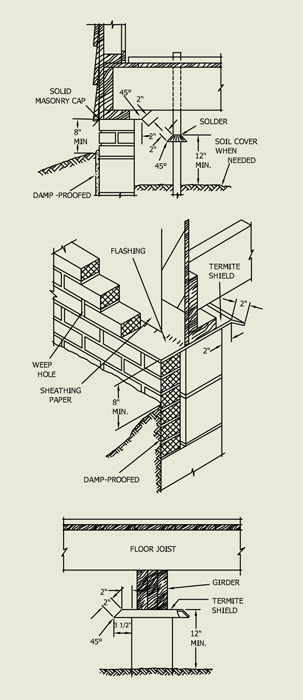
Image courtesy of the American Wood Council
Installing termite shields has proven to be an effective means of control.
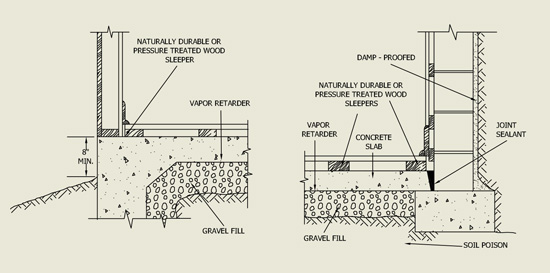
Image courtesy of the American Wood Council
An example of termite control for slab-on-ground construction.
Code Requirements
Termite requirements are currently included in the International Building Code (IBC), International Residential Code (IRC), state codes, and certain local codes and ordinances. While verbiage may differ, these codes often have similar requirements, including pest control tactics, the use of licensed companies, contracts, notices of treatment, inspection, and certificate of compliance. Some requirements are based on level of risk; for example, the IBC refers to “geographical areas where hazard of termite damage is known to be very heavy” regarding the treatment of wood floor framing. The hazard map shown below, is taken from the 2018 IBC.
To avoid decay caused by fungi and termite infestation it is critical to separate untreated wood from exposed earth by a minimum of 8 inches. Wood siding must be separated by a minimum of 6” from exposed earth. Such separations are recommended by industry and required by current codes, including Section 2304.12 of the 2021 International Building Code. This section addresses protection against decay and termites and sets out requirement for multi-family and non-residential construction applications.
To protect framing at the connections to foundation, 2021 IBC Section 2304.12 requires that specific wood framing members of a building be protected against decay and termites. Protection can be provided by using either naturally durable or preservative-treated wood.
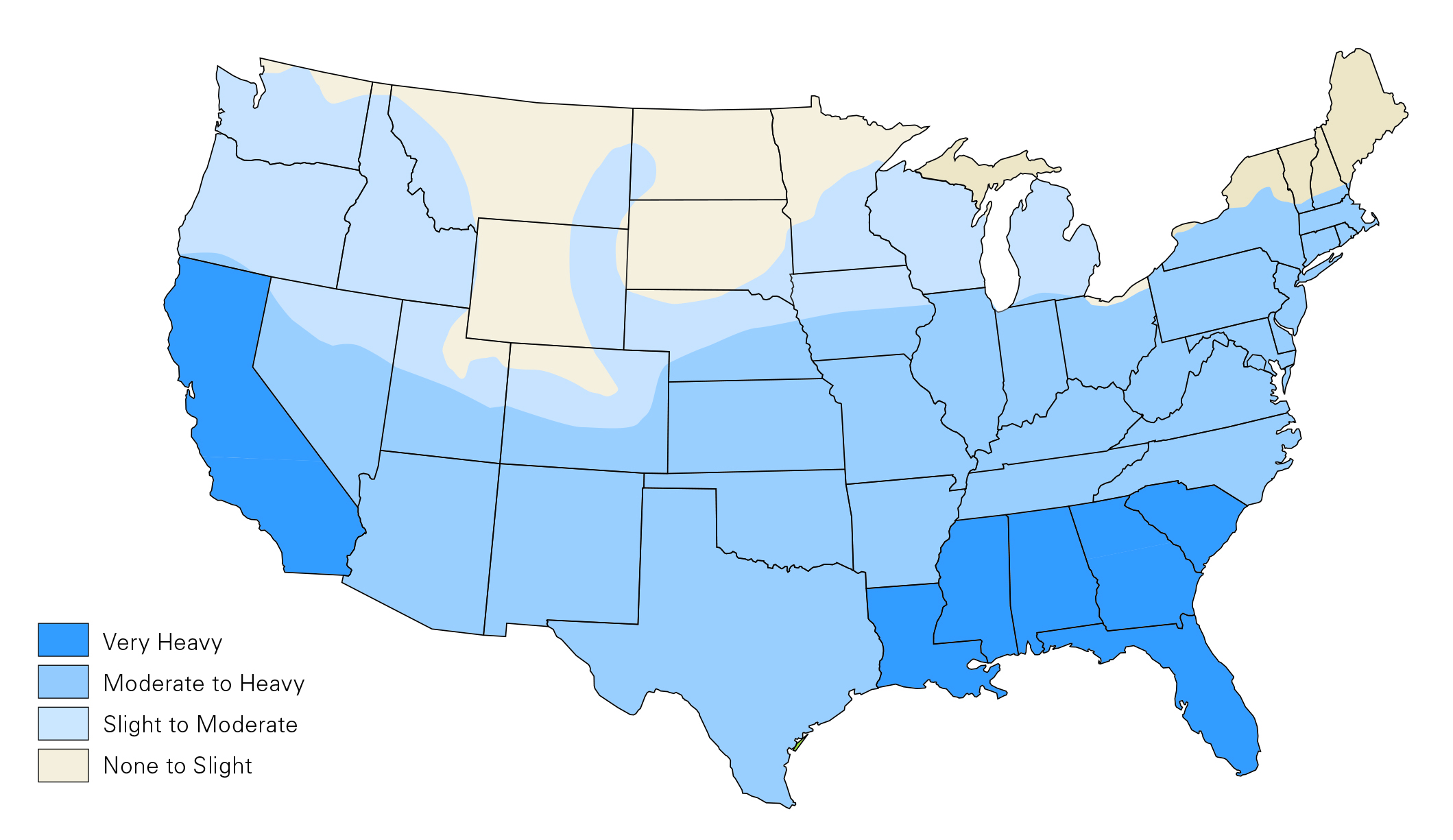
Termite Probability Map Source: 2021 IBC Figure 2603.8 Relative hazard of subterranean termite infestations in the United States
Western red cedar’s unique properties make it ideal for weather-resistant applications, including roof shingles, decking, exterior siding, and exterior cladding. The building faces the western Cascade mountain range and has achieved Earth Advantage Gold certification.
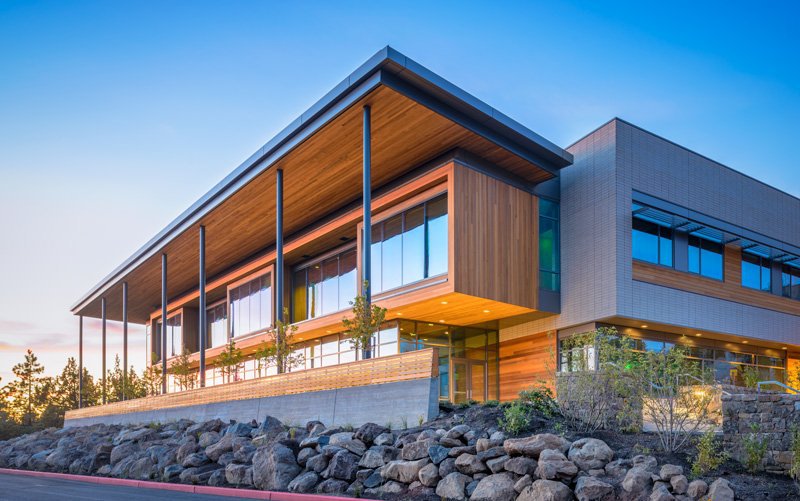
Photo courtesy: Alan Brandt Photography
Central Oregon Community College, Science Center | Pinnacle Architecture.
Wood that is naturally durable for decay and termites, as defined in IBC Chapter 2, includes the heartwood of redwood, Alaska yellow cedar, eastern red cedar, and western red cedar. Preservative-treated wood typically needs to comply with IBC 2303.1.9. Preservative-treated southern pine is distributed throughout much of the United States, while preservative-treated Douglas fir and hem-fir are also commonly distributed in the western states. Preservative treated Douglas fir and hem-fir are often incised to improve their treatment absorption. Because the incising process cuts a small percentage of wood fibers in the lumber, for structural applications, the reduction in strength must be accounted for using the incising factor prescribed by the referenced design standard, the National Design Specification® (NDS) for Wood Construction, available from the American Wood Council.
The required use of treated wood or a naturally durable species is dictated by the proximity of the wood to earth or to concrete in contact with earth.
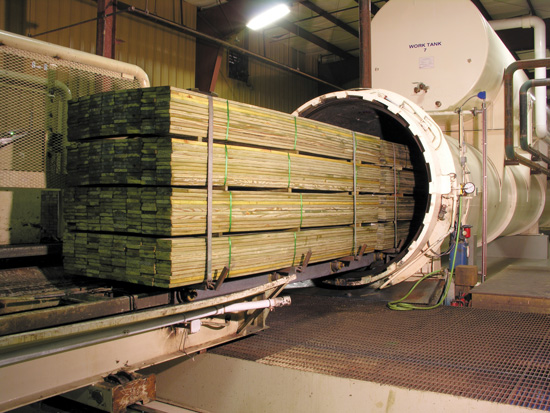
Photo courtesy of BS&S Treated Lumber
The IBC requires specific wood framing members of a building to be protected against decay and termites. Protection can be provided by using either naturally durable or preservative-treated wood.
Sill plates and wood sleepers on concrete in direct contact with the earth, such as a foundation wall or slab-on-grade, require protection. Sills can be protected from moisture migration from the concrete by installation of a sill sealer between the concrete and sill. Such sill sealers are often self-adhesive closed cell foam ribbons installed on the concrete before placing the sill. Not only do sill sealers act as a capillary break for moisture migration, they also serve as an air seal, eliminating potential gaps beneath the sill, and as a small thermal break between the concrete and framing.
In raised floors, wood joists and underlayment are best constructed at least 18 inches from exposed ground and wood girders at least 12 inches from exposed ground. With less clearance, the IBC requires the members to be naturally durable or preservative-treated wood.
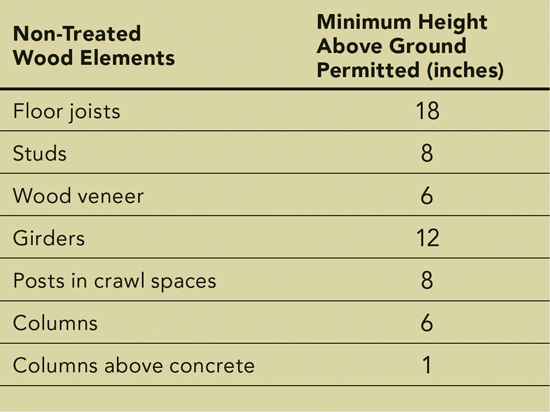
Courtesy of the American Wood Council
Height above ground of non-treated wood elements. Based on the U.S. model building codes and American Wood Council recommendations.
At the exterior of the buildings, it is good practice to provide vertical clearance between the ground and any wood members. A stem wall in a raised floor or a curb made of concrete or masonry on a slab-on-grade foundation can provide the required clearance. Alternatively, the top of a foundation slab is located at an elevation to provide the desired vertical clearance at the exterior edges. Wood framing members, such as studs and wood structural sheathing, are best located at least 8 inches above earth. Below that, IBC 2304.11.2.2 requires wood framing on foundation walls to be naturally durable or preservative-treated wood.
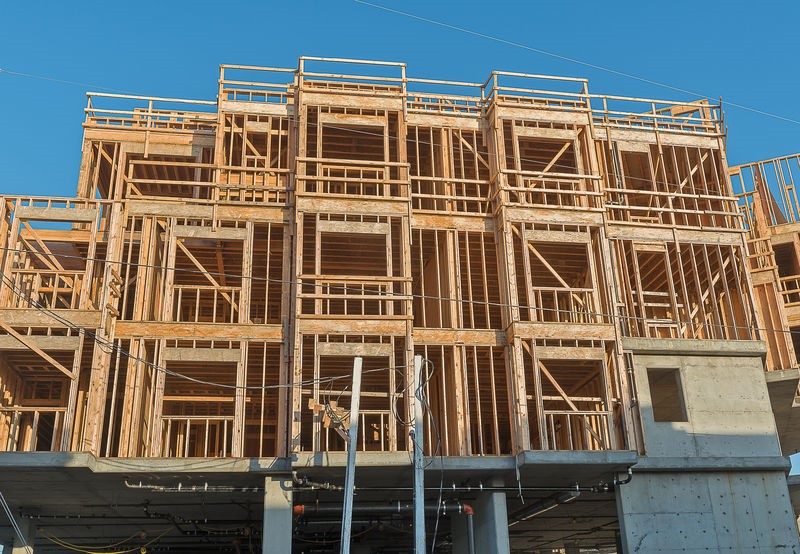
Podium Construction: An Alternative Approach to Termite Protection
In podium construction multiple stories of light wood framing are built over a single or multi-story concrete podium. This method can increase termite protection if the poured concrete level is left exposed. Instead of traditional code requirements, which entail 6 to 8 inches of clearance, a single-story podium creates between 10 and 15 feet of clearance between the wood framing and ground. Using podium construction’s enhanced clearance prevents termite access, eliminates the issue of having soil or landscaping encroach on the clearance over time, and simplifies inspection. For geographic areas that are prone to flooding, podium construction also facilitates a quicker drying process for wood-frame stories after a storm. Depending on region and hazard assessment, using the podium construction method can create enough reduction in risk to choose wood-frame construction in termite-prone areas, allowing building owners to benefit from wood construction’s economy, design flexibility, construction speed, and light carbon footprint.
Design Note: If the podium level is covered with brick or other cladding, minimum clearance would be needed to allow proper inspection, just like a non-podium structure.
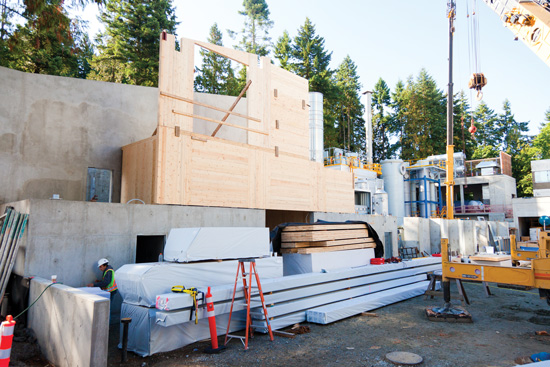
Photo courtesy of KK Law
Once delivered to the construction site, wood should be stored and wrapped properly.
Construction: Keeping Wood Durable
Informed design is essential to durability, but encouraging proper material handling during construction will greatly improve the long-term performance of wood material in the building envelope. “While an architect’s role typically does not extend beyond specification of wood to materials handling and construction practices, specifications can state S-DRY or KD lumber as well as 19 percent maximum moisture content at time of enclosure,” says Paul Morris, research leader, durability and building enclosure at FPInnovations. “It would also be ideal if architects provided recommendations on how wood should be treated during construction. Even something as elementary as requiring field treatment of saw cuts in treated wood to seal newly exposed untreated wood would help protect the structure’s long-term durability.”
Weather Protection
Advanced planning to protect wood during construction can contribute to long-term durability. Material delivery should be timed as close to the installation date as possible. Too often, wood construction products, even for interior use, arrive at the construction site and are left outside and exposed to the elements, absorbing moisture from rain, snow, puddles, or soil. If wood does need to be stored for any length of time, a clean, well-drained material storage area is critical. Upon arrival, wood should be inspected to see that wrappers are intact—faulty ones should be replaced with heavy tarp—and then stored 6-8 inches off the ground away from ponding water. If the soil is wet or poorly drained, a polyethylene tarp or a temporary gravel pad should be placed on the ground below as supports for the materials. The storage area should also be free of vegetation which can harbor insects, hamper ventilation, and maintain moisture in the air.
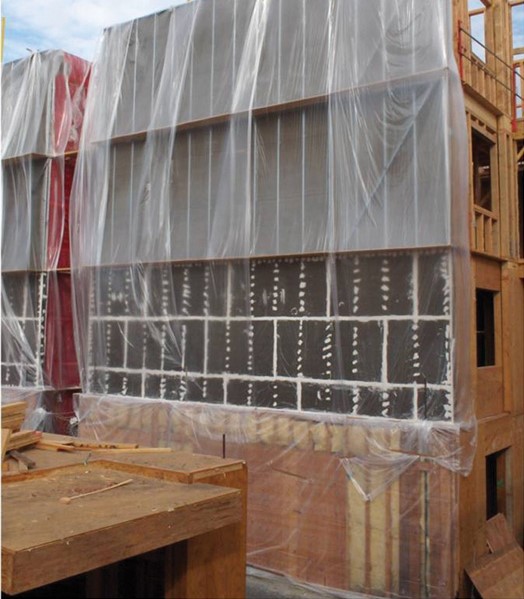
Photo courtesy of Togawa Smith Martin, Inc.
This photo shows how a multi-story wood building can be protected from the elements.
After installation, the structure should be protected from rain and other sources of bulk water by installing roof coverings and moisture barriers on the exterior of the building envelope as soon as practicable. If elevated moisture levels exist, materials inside the building envelope should be adequately dried before installing insulation and other materials. It is best to avoid the premature application of interior membranes like gypsum wallboard. Allowing the wood framing to acclimate and lower its moisture content to the extent reasonable is highly desirable.
If lumber has been significantly wetted during construction, schedules should allow for drying of framing and sheathing materials to an MC of 19 percent or below. Moisture barriers, installed soon after assemblies are framed, will reduce exposure to weather. If needed, artificial heat and/or dehumidification can accelerate drying.
Buildings that Work
Over the years, research and experience have identified several key characteristics of wood buildings that last.
Dry Buildings
As has been discussed, controlling moisture is a key factor in ensuring durability. Wood meant for a dry structure must start out dry and stay dry. Buy dry wood, store it properly, design the building to keep the wood dry, and observe proper maintenance practices. This is fundamental to an approach called “durability by design.”
For example, if wood is in direct contact with concrete outdoors, moisture can accumulate unless the concrete is detailed to drain away from the wood. Moisture can be a problem in basements because they are surrounded by soil and basement walls are subject to penetration by tiny amounts of water through concrete foundation walls. This can be prevented by use of an effective moisture barrier.
Buildings with Quality Assurance
For long-term durability, conformance to requirements of the building code is essential at every stage of the building process. Inspection is required for all construction materials covered by the building code and is typically performed by the local code agency. Special inspection by third-party agencies for construction practices critical to the building’s structural capability, such as tight diaphragm nailing in high seismic areas, are enumerated in Chapter 17 of the IBC, Structural Tests and Special Inspections. Treated wood products should confirm to AWPA standards, and should carry the quality mark of an accredited inspection agency of the American Lumber Standard Committee (ALSC) or ICC Evaluation Service.
Buildings that are Properly Maintained
Also essential to building longevity is regular maintenance, repair, and renewal. Five years after installation (or sooner), wood exposed on the exterior should be inspected, and then every two years thereafter. Sunken paint and surface collapse both indicate subsurface wood decay, which requires repair. To minimize moisture problems, cladding should be inspected annually for signs of wear and for green algae stains; through-wall flashing should be examined for brown stains. Exposed wood should be properly painted, stained or otherwise protected. Re-treat with termiticides at appropriate intervals. Heavy shrubbery should be kept from exterior walls, and sprinklers pointed away from wood walls. Roof gutters should be kept unclogged. Any plumbing leaks should be promptly repaired.

Photo courtesy of Stephanie Tracey
The Sustainability of Longer Service and End of Life Solutions
Durability is a key component of sustainability. Before making a large investment in a building, it is important to consider its environmental impacts versus realistic lifespan. Traditionally, building materials follow a ‘take, make, dispose’ linear consumption model, where resources are taken from the earth for manufacture and the products are disposed of at the end of their life (Sustainable Construction Solutions, http://www.susconsol.co.uk/blog/timber-and-the-circular-economy/). In contrast, materials and their buildings which seek to maximize lifecycle, adopt a circular use pattern. Waste is designed out by keeping products and materials in constant use, and at the end, recycling the materials. When designing something for the long term, ensuring that its materials can be reused or remanufactured at the end of their use cycle reduces reliance on finite resources.
In surveys of building age, wood buildings consistently have the longest lifespans. This demonstrates that wood structural systems are capable of longevity. However, wood is also adept at reconfiguration, reuse, and recycling. Considering the embodied energy in demolished buildings and the implications of material disposal, the fact that wood is adaptable either through renovation or deconstruction and reuse becomes a significant advantage. Wood beams can be removed and placed into new configurations; wood floors can be taken up and used for paneling; wood waste can be recycled. Recommended building approaches to optimize end-of-life reuse include1 :
- Use screws and bolts instead of nails, along with connection techniques that lessen wood damage.
- Use robust moisture management techniques to protect wood from decay and insect damage.
- Label members with species and grades.
- Avoid adhesives, such as when fastening floor sheathing to joists.
Many architects believe wood can add to a building’s longevity, and thus sustainability, not only because of its physical properties, but because wood buildings tend to be valuable to their occupants for reasons related to aesthetics, comfort, and innate positive human response to wood. Marc L’Italien, whose architecture firm EHDD often uses wood materials on its projects, puts it this way: “Whenever we can, we select materials with integral finish, both from a sustainability angle and because there is inherent beauty in well-detailed natural materials. This is one of the most overlooked aspects of sustainability. It’s not about the [green rating system] points. It’s about designing places where people want to be. The more they like their environments, the less likely these structures are to be demolished. A strong following and internal flexibility allow them to be repurposed when the users and owners change over time.”
Wood: A Material of Choice
Because of its cost effectiveness, ease and efficiency of construction, versatility, and sustainability, wood will continue to be a material of choice for many structural applications. Protecting the longevity of wood buildings starts with good design and construction practices—both areas in which architects can influence the optimum use of wood. When appropriate steps are taken, architects can tap the virtually unlimited design possibilities of wood, while delivering buildings that will perform well for owners, occupants, and the environment—and for decades to come.
For more detailed information on the subjects covered in this CEU, a new version of the American Wood Council’s Code Conforming Wood Design based on the 2018 CCWD is available as a free download at www.awc.org.
References
- Design of Wood-Frame Structures for Permanence, American Wood Council
- Managing Moisture and Wood, Canadian Wood Council
- Moisture and Wood-Frame Buildings, Canadian Wood Council
- Guide for Designing Energy-Efficient Building Enclosures for Wood-Frame Multi-Unit Residential Buildings in Marine to Cold Climate Zones in North America, Finch, G., J. Wang, and D. Ricketts, 2013
- A new version of the American Wood Council’s Code Conforming Wood Design based on the 2018 CCWD is available as a free download at www.awc.org.
- Effective Termite Protection for Multi-Family & Commercial Wood Buildings, WoodWorks Wood Products Council
- Survey on Actual Service Lives for North American Buildings, FPInnovations, Proceedings, 10th International Conference on Durability of Building Materials and Components, O’Connor, J., Horst J.S., Argeles, C, 2005,
cwc.ca/wp-content/uploads/2013/12/DurabilityService_Life_E.pdf - Corrosion of structural steel,
www.steelconstruction.info/Corrosion_of_structural_steel - Types and Causes of Concrete Deterioration, Portland Cement Association,
www.cement.org/docs/default-source/fc_concrete_technology/durability/is536-types-and-causes-of-concrete-deterioration.pdf?sfvrsn=4 - Designing Buildings Wiki,
www.designingbuildings.co.uk/wiki/Spalling#Brickwork_spalling - Decay initiation in plywood, OSB and solid wood under marginal moisture conditions. The International Research Group on Wood Protection, Document No. IRG/WP 11-20469, Wang, J., Morris, P.I. 2011,
www.cabdirect.org/cabdirect/abstract/20113340933 - About Moisture and Wood, Canadian Wood Council,
cwc.ca/why-build-with-wood/strong/durability/moisture-and-decay/about-moisture-and-wood - Moisture and Wood-Frame Buildings,
www.canadawood.cn/english/downloads/pdf/moisture/moisture_english.pdf - Designing for durable wood construction: the 4 Ds. Durability of Building Materials and Components, Hazleden, D.G., Morris, P.I. 1999,
www.irbnet.de/daten/iconda/CIB2272.pdf - Build a Better Home: Mold and Mildew, APA: Engineered Wood Association,
www.fpl.fs.fed.us/documnts/informationalkits/infokit_0011_Mold_A525.pdf - Integrated control of subterranean termites: the 6s approach, Proceedings American Wood Preservers’ Association Annual Meeting, Morris, P.I. 2000,(96): 93-106,
www.softwoodlumber.org/pdfs/Integrated_Control_of_Subterranean_Termites.pdf - North Carolina Department of Agriculture and Consumer Services,
www.ncagr.gov/SPCAP/structural/pubs/preconstruction.htm - American Wood Protection Association,
www.awpa.com/standards/organization.asp - Bridge Inspection for Decay and other Deterioration, Minnesota Department of Transportation,
www.dot.state.mn.us/bridge/pdf/insp/USFS-TimberBridgeManual/em7700_8_chapter13.pdf
Endnotes

|
Think Wood provides commercial, multifamily, and single-family home design and build resources to architects, developers, and contractors, including education, research, design tools, and innovative project profiles. For additional information, please visit www.thinkwood.com. |


